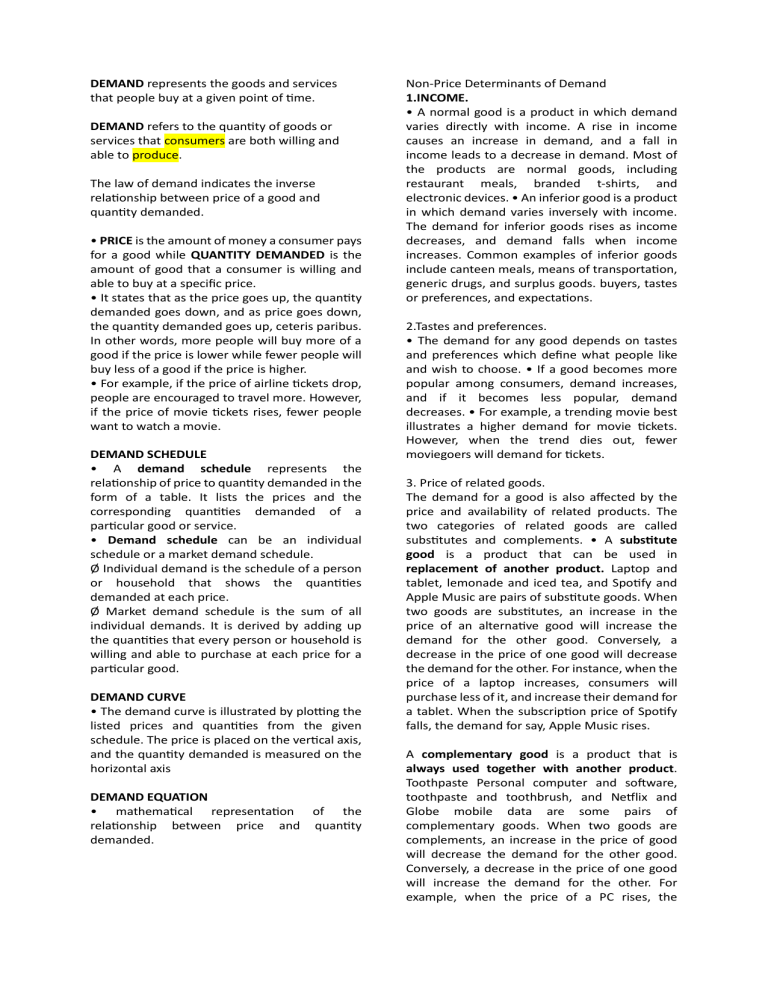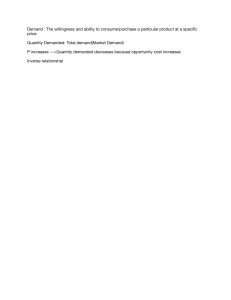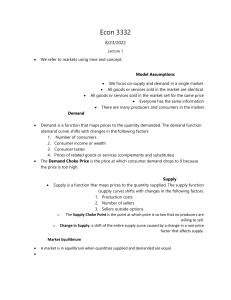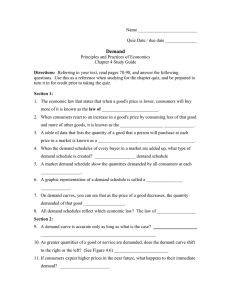
DEMAND represents the goods and services that people buy at a given point of time. DEMAND refers to the quantity of goods or services that consumers are both willing and able to produce. The law of demand indicates the inverse relationship between price of a good and quantity demanded. • PRICE is the amount of money a consumer pays for a good while QUANTITY DEMANDED is the amount of good that a consumer is willing and able to buy at a specific price. • It states that as the price goes up, the quantity demanded goes down, and as price goes down, the quantity demanded goes up, ceteris paribus. In other words, more people will buy more of a good if the price is lower while fewer people will buy less of a good if the price is higher. • For example, if the price of airline tickets drop, people are encouraged to travel more. However, if the price of movie tickets rises, fewer people want to watch a movie. DEMAND SCHEDULE • A demand schedule represents the relationship of price to quantity demanded in the form of a table. It lists the prices and the corresponding quantities demanded of a particular good or service. • Demand schedule can be an individual schedule or a market demand schedule. Ø Individual demand is the schedule of a person or household that shows the quantities demanded at each price. Ø Market demand schedule is the sum of all individual demands. It is derived by adding up the quantities that every person or household is willing and able to purchase at each price for a particular good. DEMAND CURVE • The demand curve is illustrated by plotting the listed prices and quantities from the given schedule. The price is placed on the vertical axis, and the quantity demanded is measured on the horizontal axis DEMAND EQUATION • mathematical representation of the relationship between price and quantity demanded. Non-Price Determinants of Demand 1.INCOME. • A normal good is a product in which demand varies directly with income. A rise in income causes an increase in demand, and a fall in income leads to a decrease in demand. Most of the products are normal goods, including restaurant meals, branded t-shirts, and electronic devices. • An inferior good is a product in which demand varies inversely with income. The demand for inferior goods rises as income decreases, and demand falls when income increases. Common examples of inferior goods include canteen meals, means of transportation, generic drugs, and surplus goods. buyers, tastes or preferences, and expectations. 2.Tastes and preferences. • The demand for any good depends on tastes and preferences which define what people like and wish to choose. • If a good becomes more popular among consumers, demand increases, and if it becomes less popular, demand decreases. • For example, a trending movie best illustrates a higher demand for movie tickets. However, when the trend dies out, fewer moviegoers will demand for tickets. 3. Price of related goods. The demand for a good is also affected by the price and availability of related products. The two categories of related goods are called substitutes and complements. • A substitute good is a product that can be used in replacement of another product. Laptop and tablet, lemonade and iced tea, and Spotify and Apple Music are pairs of substitute goods. When two goods are substitutes, an increase in the price of an alternative good will increase the demand for the other good. Conversely, a decrease in the price of one good will decrease the demand for the other. For instance, when the price of a laptop increases, consumers will purchase less of it, and increase their demand for a tablet. When the subscription price of Spotify falls, the demand for say, Apple Music rises. A complementary good is a product that is always used together with another product. Toothpaste Personal computer and software, toothpaste and toothbrush, and Netflix and Globe mobile data are some pairs of complementary goods. When two goods are complements, an increase in the price of good will decrease the demand for the other good. Conversely, a decrease in the price of one good will increase the demand for the other. For example, when the price of a PC rises, the demand for software applications will increase. When the subscription price of Netflix falls, consumers will increase their demand for Globe mobile internet. 4.Number of buyers. Population and market size determines the number of consumers buying a good or service. The population clearly affects the demand for any good. A higher population or greater market size results in higher demand, while a lower population or market size takes the reverse situation. The Philippines’ 108 million people will buy fewer bananas and smartphones than China’s 1.4 billion individuals. An increase in the market size for Korean barbecue in the Philippines leads to higher demand among Filipinos for samgyupsal. 5. Expectations Ø consumers' expectations can influence the demand of many items, which can affect the demand for a good at present. These expectations comprise price and buyer’s income. Consumers who expect the price of a good to increase in the future may prompt them to buy today, thus increasing the current demand for the good. Conversely, those who expect the price of a good to fall in the future may cause them to buy the good later, thus decreasing the current demand for the good. SUPPLY refers to the quantity of goods or services that sellers are both willing and able to sell at certain conditions. INDIVIDUAL SUPPLY shows the quantities supplied at each price by one firm. MARKET SUPPLY is the sum of the individual supply schedules of all firms in the industry. THE LAW OF SUPPLY is the microeconomic law that states that, all other factors being equal, as the price of a good or service increases, the quantity of goods or services that suppliers offer will increase, and vice versa. It explains how firms react to changes in price. For example, if the price of mangoes in the market increases, farmers are encouraged to produce more. A supply schedule represents the relationship of price to quantity supplied in a table form. In other words, it lists the prices and the corresponding quantities supplied for a particular good or service. The law of supply can be graphed using the supply curve, which serves as the graphical representation of the supply schedule. Mathematical representation of the relationship between price and quantity supplied. A change in supply occurs whenever there is a change in non-price determinants of supply— input costs, technology, number of producers, expectations, government actions, and unpredictable events, ceteris paribus. For instance, when the costs of production rise, this causes the quantity supplied to change. The change in supply is represented by the shift of the supply curve. A rightward shift means increase in supply while a leftward shift indicates decrease in supply. t. The shift of the demand curve from S1 to S2 or S2 to S1 is shown in Figure 6.3. Non-Price Determinants of Supply 1. Input Costs. Firms incur costs when they produce goods and services including the prices of raw materials, rents, wages of workers, interests and others inputs of production. Input costs are a key factor that determines supply. If the input costs become more expensive, the supply decreases. Consider for example, a rise in the wages among workers will increase the production costs of a firm and will lower its supply. A substantial fall in the price of gasoline will likely decrease the costs of production, therefore, increase supply. 2. Technology. Advances in technology may change the level of supply. Technology improves the productivity of workers and increases the efficiency of the production process. An improvement in technology leads to an increase in supply. For example, the application of technology like the use of industrial robots causes an increase in supply of many consumer electronics products such as smartphones. Also, modern technology in agriculture helps farmers to plant and produce more crops like corn, rice and the like. 3. Number of producers. Market supply also depends on the number of producers in the market or industry. An increase in the number of producers may lead to an increase in supply of goods and services. For example, if a new restaurant opens and offers lunch meals in a city, supply of meals will likely increase. 4. Price expectation. Like buyers, firms expect the price of their goods to increase or decrease in the future, which may affect their current supply. If price is expected to rise in the future, current supply decreases, and if it’s expected to fall, supply increases. Take for instance, a manufacturer anticipates the price of shoes to go higher in the future so it cuts the quantity it will sell, thereby decreasing supply. On the other hand, a farmer expects the price of rice to decrease next year, so he decides to produce and sell more rice this year, thus, increasing supply. 5. Government actions. Government actions through the implementation of policies may cause supply to change. These government actions involve granting subsidies or raising various taxes. A subsidy is an incentive provided to firms by the government that can improve the supply of a certain good. Subsidies tend to increase market supply. Tax is an enforced contribution imposed by the government to firms. Taxes tend to cut supply as it raises the costs of production. For example, the implementation of TRAIN law in the Philippines increases the excise tax on sweetened beverages, therefore, decreases the supply of these products. 6. Unpredictable events. Unpredictable events happened in a firm, caused by nature, the economy, and other unforeseen circumstances may change the level of supply. These include labor and industrial disputes, machine failure, bad weather due to typhoons and floods, agricultural pests affecting crops, shortage of imported commodities due to global recession, among others. The COVID-19 pandemic is one straightforward example as it disrupts the global supply chain of commodities where exports and imports have declined to all regions across the world affecting the supply of many commodities.





